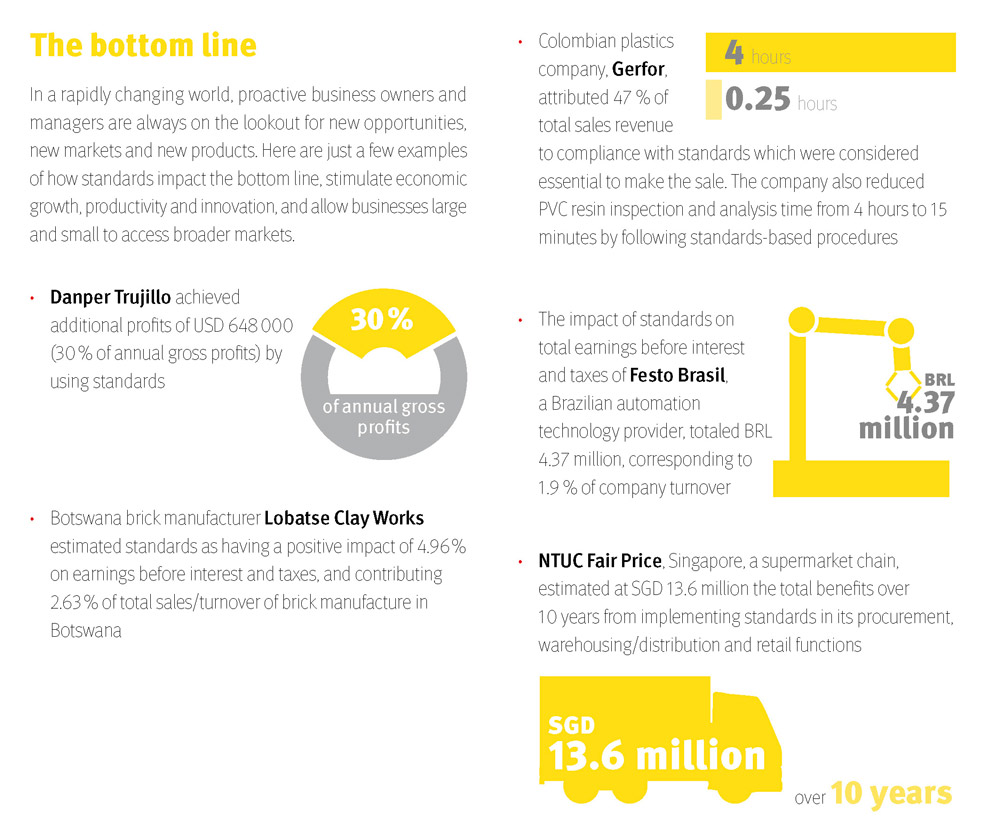How many times have you left a meeting and doubted that anything was actually going to change in your company’s strategy? This is all the more difficult when time and money are of the essence. All too often, we get together to flesh out a strategy and assess, among other things, how and where standards fit into the picture – and nothing is accomplished. It’s frustrating.
Standards have a direct impact on the bottom line.
Some see standards as a passport to export markets, some as a necessary evil or a hoop to jump through, and others still as the priceless knowledge of experts. But whatever side of the fence you’re on, you will have to admit that standards are rarely described in numbers. Take, for instance, the percentage of increased sales or GDP growth that may result from their use. We know that numbers speak volumes, all the more so when there is a dollar or euro sign in front of them.
But is it even possible to quantify the benefits that standards bring? Short answer: Yes, it is. Standards have a direct impact on the bottom line, which you can calculate. The cost of standardization has always been relatively easy to determine, but the calculation of its benefits was much trickier... until recently.
Backed by demand
You can now find out how your company can assess and communicate the economic benefits of standards, and pinpoint exactly which areas are likely to result in the highest benefits. This has been the focus of a long-term study by ISO and its members in which around 30 companies, and even one whole industry sector, have scrutinized the way they use standards and calculated the savings that have been made. From a Russian brewery passionate about quality (see the infographic) to a small German company in the business of positioning technology, the numbers make for an interesting read.
Of course, the picture is very diverse, with varying experiences depending on company size, sector and use of standards. The companies surveyed range from small businesses with 25 employees and an annual sales revenue of around USD 4.5 million, to conglomerates of several thousand employees with an annual revenue of more than USD 1.5 billion. They operate in a variety of business sectors, such as food, construction and telecommunications. But for all these companies, benefits were seen, usually between 0.15 % and 5 % of a company’s annual sales revenues .
Singapore sings praise

The other significant news to come out of the studies is the industry-sector impact. A case in point is Singapore’s building and construction industry. Several years ago, the billion-dollar industry sector introduced its first national IT standard, SS CP 83, a CAD standard for technical drawings. The standard improved the productivity and efficiency of the work processes within the industry enabling the exchange of drawings and the successful roll-out of CORENET (Construction and Real Estate Network) for the electronic submission of drawings for review and approval to regulatory agencies.
So the industry applied CP 83 throughout its value chain for technical drawings in design, planning, operation, testing and commissioning. The use of the standard made it possible to exchange technical drawings electronically between different architects, engineering and design firms, overcoming the need for printouts of drawings.
What tipped the scales was the overwhelming benefits: economic savings of approximately SGD 320 million (USD 250 million) to the Singaporean construction sector (between 2003 and 2012). So how did the standard contribute to the economic returns of the industry?
In a nutshell, the benefits derived resulted from the:
- Cost and efforts spared from having to prepare drawings for project discussions and submissions
- Time spent on the interpretation of drawings
- Cost savings for going from paper to electronic media
- Savings from reduced commuting
- Transfer of employee know-how from one company to the next
Standardization was not a foolish use of corporate funds.
The Singapore experience highlights the benefits of using a unified standard for the whole industry. From design and manufacturing to distribution and marketing, all aspects of the industry’s products and services were affected at some point by standardization. The implementation of CP 83 – together with the enabling of the CORENET e-submission – significantly enhanced communication and coordination amongst the stakeholders in the design process, as well as helping to achieve substantial economic benefits. For these companies and others, standardization was not a foolish use of corporate funds. It was key to raising productivity and efficiency across the construction value chain.
Numbers speak volumes

Over the past decade, increasing interest has been taken to qualify and quantify the economic and social benefits of standards. But how much of an impact on the national scale are we talking about? A series of recent studies conducted in Germany and the UK point to a direct relationship between the use of standards and economic growth, labour productivity, ability to export and more.
A study in the UK by the Department of Industry and BSI, the ISO member for the country, has estimated that standards make a contribution of GBP 2.5 billion to the UK economy and attributes to standards 13 % of the improvement in labour productivity in recent years. Likewise, DIN, the German member of ISO, has determined that the benefits of standards represent 1 % of the gross domestic product. Similar studies in the USA, Australia and Canada corroborate these findings.


